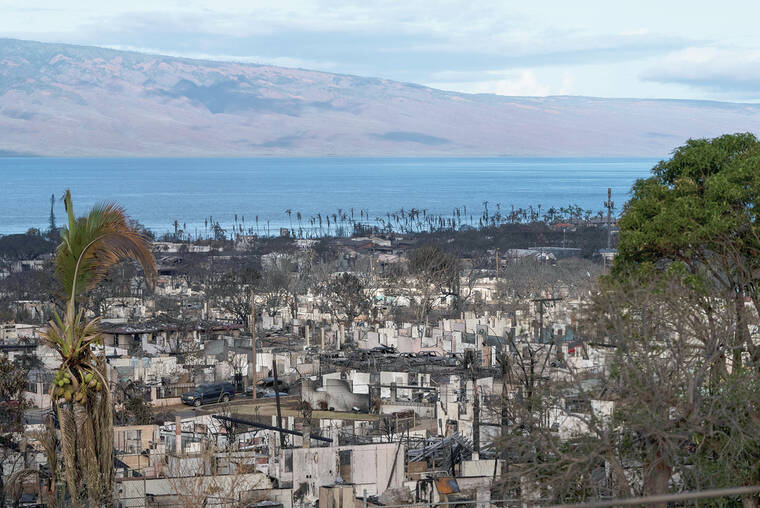LAHAINA, Hawai‘i — The University of Hawai‘i Economic Research Organization (UHERO) today released an updated financial forecast for Hawai‘i, painting a picture of ongoing hardship and a slow recovery on Maui following the summer wildfires that killed at least 97 and caused $5.5 billion in damages.
“The tragic Maui wildfires that began in August have inflicted deep pain in lives lost, families torn from their homes, and a way of life damaged or destroyed,” the report’s authors wrote. “Addressing these losses will be an ongoing process for individual families and the Lahaina and broader Maui communities.”
“At the same time, there are economic costs for the county and the state as a whole, many of which will last well into the future.”
Across Maui, financial disruption from the fires could be felt immediately. Visitor arrivals plummeted by nearly three-quarters, as would-be travelers avoided the island, due in part to early messaging suggesting tourists stay away. As a result, Maui has lost $13 million in revenue per day in the weeks following the fires, according to the report.
However, the Valley Isle has already seen some recovery, UHERO reported, with the most notable financial gains anticipated in South Maui and Central Maui. While West Maui resorts not directly impacted are set to open on Oct. 8, the region’s recovery will likely be significantly slower, the report said.
While Maui has slowly begun to bring visitors back, UHERO stressed that a return to pre-inferno visitor levels isn’t expected to happen anytime soon, writing that a full islandwide recovery will not be reached by 2026, the end of the report’s forecast period.
Between fewer visitors flying in and the vast majority of Lahaina businesses destroyed, job losses on Maui has and will continue to skyrocket, UHERO said.
“Weekly initial unemployment insurance claims were running in the 100 to 150 range in the first half of the year, similar to levels we saw prior to the pandemic,” the report reads. “And then the fires hit.”
“Just one week after the fire, initial unemployment insurance claims jumped to more than 800 claims. A week later, initial claims skyrocketed to nearly 4,500. So far, there have been a total of 11,995 new claims since the disaster. This is about 11,300 more claims than before the fire.”
According to the report, Maui’s unemployment rate is expected to soar above 11 percent during the fiscal year’s fourth quarter. Furthermore, unemployment is expected to only gradually recede, and will likely not dip below 4 percent until late 2026.
The inferno’s fallout won’t only be felt on Maui, however. Statewide, income growth for fiscal year 2024 is anticipated to reach 1.3 percent — down from an earlier estimate of 4 percent.
“GDP will be raised somewhat by rebuilding,” the report reads, “but this does not capture the value of lost homes and businesses and the non-pecuniary costs of displacement, trauma and so forth.”
Still, the report notes that businesses and residents on Maui’s neighboring islands will likely only face minimal impacts.
The construction industry is likely to be most impacted as West Maui’s recovery efforts drive up demand, the report said. UHERO noted that projects on other islands may be delayed, and construction costs will certainly increase.
All other sectors in Hawai‘i should remain largely unchanged following the fires though, according to the report. UHERO even suggested many would-be Maui visitors will likely substitute their vacation for another island experience — primarily, Kaua‘i and Hawai‘i Island.
However, this safety net may not be able to survive a larger-scale economic downturn. UHERO noted the hit to the statewide economy has left Hawai‘i more vulnerable to financial shocks originating beyond its shores.
“While the U.S. economy is on firmer footing than we expected even a few months ago, it is far from clear that the battle against inflation will be won without a recession,” the report reads. “And global conditions are more precarious than before. So more than is usually the case, a sharp drop in vacation demand could pull our local economy into a downturn. Let’s hope that can be avoided.”
•••
Jackson Healy, reporter, can be reached at 808-647-4966 or jhealy@thegardenisland.com.


